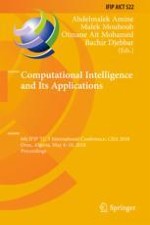2018 | Book
Computational Intelligence and Its Applications
6th IFIP TC 5 International Conference, CIIA 2018, Oran, Algeria, May 8-10, 2018, Proceedings
Editors: Prof. Abdelmalek Amine, Malek Mouhoub, Prof. Dr. Otmane Ait Mohamed, Bachir Djebbar
Publisher: Springer International Publishing
Book Series : IFIP Advances in Information and Communication Technology
